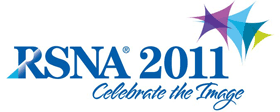
Abstract Archives of the RSNA, 2011
LL-CHS-SU7A
Dose Reduction, Image Quality, and Diagnostic Acceptance in CT: Use of an Automatic Dose Control System with Adequate Noise Characteristic
Scientific Informal (Poster) Presentations
Presented on November 27, 2011
Presented as part of LL-CHS-SU: Chest
Patrick Stumpp MD, PhD, Presenter: Research grant, Bayer AG
Dieter Gosch PhD, Abstract Co-Author: Nothing to Disclose
Thomas Kurt Kahn MD, Abstract Co-Author: Nothing to Disclose
Hans-Dieter Nagel, Abstract Co-Author: Consultant, Koninklijke Philips Electronics NV
To study the effect of an adequate noise ADC system, characterized by a more gentle adaptation of exposure settings to body size, on the individual perception of image noise and diagnostic acceptance by radiologists in comparison to objectively measured image noise as well as the dose reductions achieved in a representative group of patients.
In this retrospective study two matched cohorts of 20 patients each were identified following the introduction of the ADC system DoseRight 2.0™ (Philips Healthcare). For the manual cohort the exposure settings were chosen according to body size for three groups: small – regular – large. For the ADC cohort the exposure settings were calculated by the ADC system according to the attenuation profile of each patient, using automatic exposure control (AEC), longitudinal dose modulation (LDM) and angular dose modulation (ADM).
12 images from 6 defined anatomical levels from contrast-enhanced scans of chest and abdomen with pelvis were analyzed by four independent readers concerning image noise and diagnostic acceptance on a five-point Likert scale. Results were compared with objectively measured image noise levels. Radiation exposure was calculated from recorded exposure data for each patient and compared for the two groups.
Use of the ADC system reduced the average effective dose for the patient by 36% in chest scans (3.2 vs. 4.9 mSv) and by 17% in scans of abdomen and pelvis (7.6 vs. 8.3 mSv).The average objective noise in all images was slightly lower in the manual cohort (11.1 vs. 12.8 HU), which correlates with a slightly better rating in the subjective noise score (4.4 vs. 4.19). However, diagnostic acceptance was rated almost equal in both cohorts with excellent image quality (averaged score 4.6 vs. 4.54; 4 = highly acceptable, 5 = excellent image quality).
Application of an ADC system with adequate noise characteristic in CT examinations leads to significant reductions in radiation exposure for patients while maintaining an excellent image quality.
For a further enforcement of the ALARA-principle in CT-examinations, the results of our study strongly encourage the use of adequate noise ADC systems.
Stumpp, P,
Gosch, D,
Kahn, T,
Nagel, H,
Dose Reduction, Image Quality, and Diagnostic Acceptance in CT: Use of an Automatic Dose Control System with Adequate Noise Characteristic. Radiological Society of North America 2011 Scientific Assembly and Annual Meeting, November 26 - December 2, 2011 ,Chicago IL.
http://archive.rsna.org/2011/11034423.html

